Temples in ancient Egypt were built for one of two reasons: to worship a particular god or a set of gods, or to commemorate a ruler. Many temples combined the two. If built for the latter, it was almost always constructed during the ruler’s reign. Seen as houses for whom they were built, temples were used for daily worship, rituals, offerings, and festive occasions.
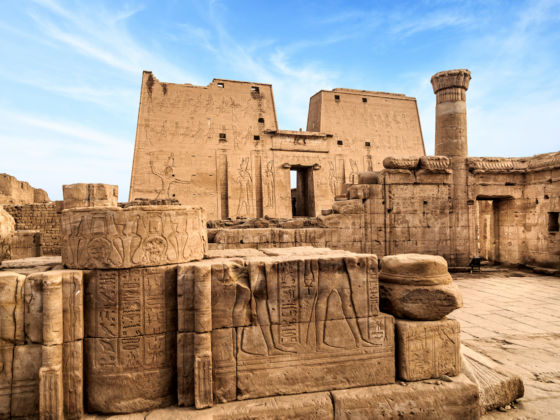
7 of the Coolest Ancient Temples in Egypt and What to See in Each
Ancient Egyptian architecture paid special attention to symmetry, and many of the temples underscore that ideal. All temples have various hieroglyphics and reliefs carved into their structures, sometimes painted as color also held significant importance in ancient Egyptian culture. The centuries and the weather have faded those colors, though some hieroglyphics retain a semblance of their original pigmentations.
Nearly all Egyptian temples have an entrance fee, and you’d be hard pressed to find one without one. They’re usually open from the early morning until early evening, and visiting at either end of the day will provide the best chance of a visit without crowds. It’s important to note that some temples, like Abu Simbel, have a separate ticket for photography and videography that you have to purchase in addition to the entry ticket if you want to be able to take photos inside; workers will constantly ask to see your ticket if they see you with your phone or camera out, so be sure to have it readily available. Deciding which temples to go to can be difficult, so we’ve done the work for you. Here’s how to visit seven of the coolest ancient Egyptian temples.
1. Abu Simbel
Abu Simbel is actually comprised of two temples; the larger is dedicated to Ramses II, pharaoh between 1279 and 1213 BC, and the smaller to his wife, then-queen Nefertari. Built during the 13th century BC, the twin temples were originally located on the west bank of the Nile, but due to rising water levels in the 1960s, they had to be relocated and make way for the Aswan High Dam that would allow Egyptians to regulate water flow. Currently, they can be found in Abu Simbel about three hours away from Aswan.
You’ll approach the temples from the opposite side of the mountain, where it looks like there’s nothing but sand, dirt, and Lake Nasser in the distance. Once you turn the final corner, the area opens up and your jaw will drop as you see the two larger-than-life temples carved into the mountainside.
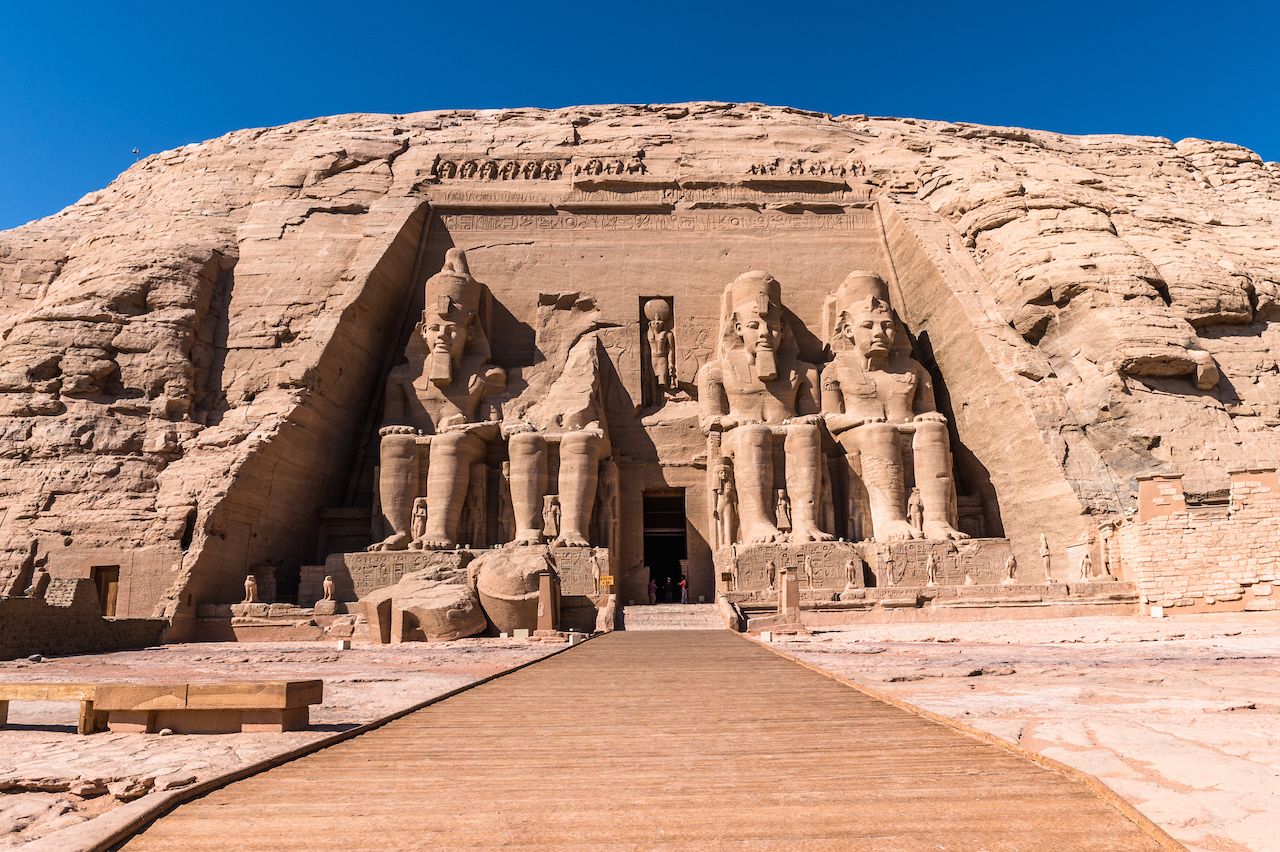
Photo: Anton_Ivanov/Shutterstock
At the temple for Ramses II, there are four enormous statues flanking its entrance, each of the pharaoh sitting down. Around the feet of the statues are smaller figures of Ramses’ mother, wife, and children. Inside, the rooms get smaller as you move from the entrance to the inner sanctuary. The first hall has eight tall statues of Ramses standing in the same dressings as the Egyptian god of the underworld, Osiris, which are meant to indicate his everlasting power. The hieroglyphics and reliefs depict the pharaoh’s strength, showing a number of images of victory in battle and against enemies. This temple was also dedicated to and used to worship the gods Ra-Horakhty, Amun, and Ptah; therefore, there are various images depicting worship to them. The inner sanctuary has four seated statues, three of the aforementioned gods, and one of Ramses II.
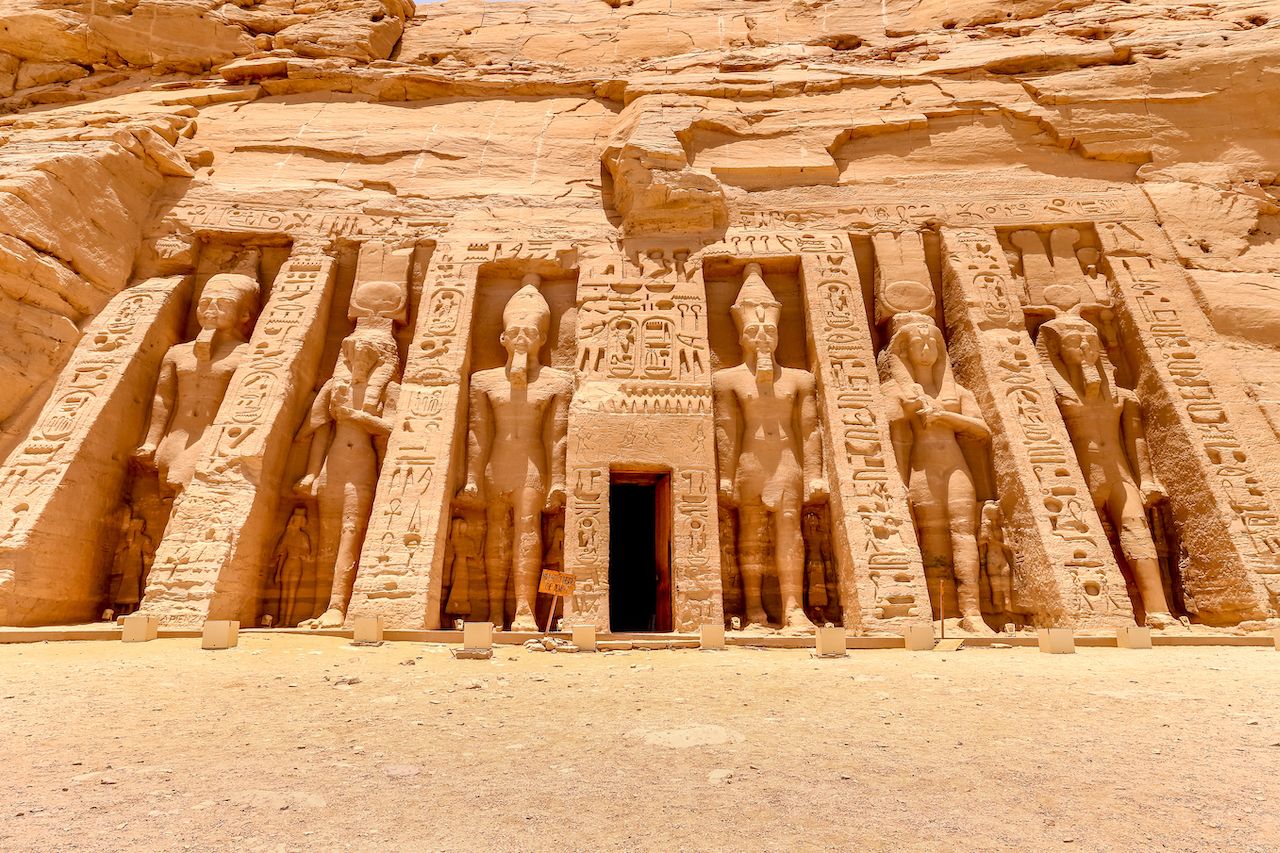
Photo: matias planas/Shutterstock
Just some 300 feet away is the temple for both queen Nefertari and Hathor, goddess of the sky. The exterior displays six standing statues, four of Ramses and two of Nefertari herself, with smaller figures of their children between them. The interior has a similar layout to its neighbor but on a much smaller scale. Instead of large, full figures in the first main hall, there are faces carved out in front of each pillar showing Hathor’s likeness. The images in this temple show both Nefertari and Ramses making offerings to various gods, as well as several of Nefertari being crowned by goddesses and outfitted in similar dressings.
Price: 200 Egyptian pounds (about $12). Photography/videography ticket is $13 extra.
Where: Aswan Governorate, Egypt
2. Temple of Hatshepsut
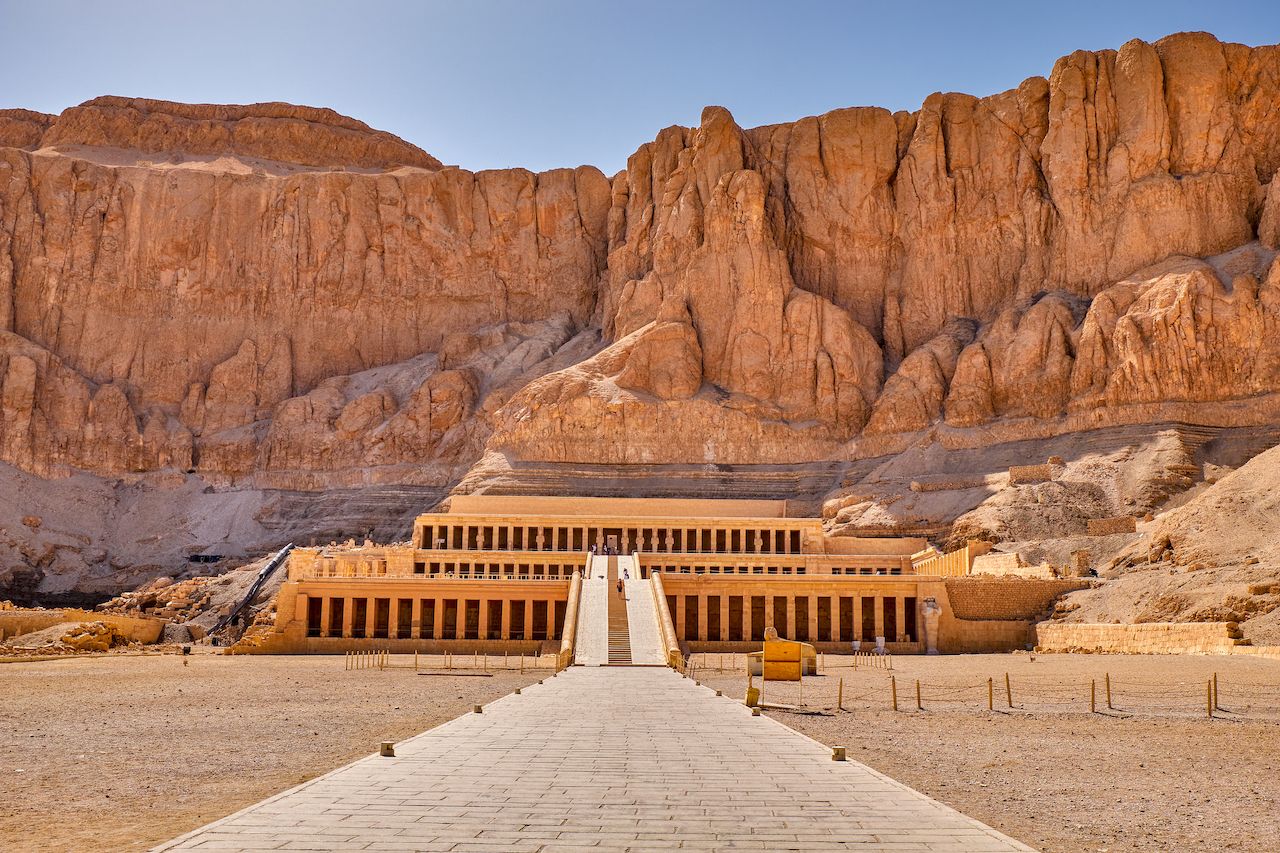
Photo: Mirko Kuzmanovic/Shutterstock
The Temple of Hatshepsut is a funerary temple located below the limestone cliffs of Deir el-Bahari. While it does contain everything a traditional Egyptian temple would (such as multiple courtyards and an inner sanctuary), the exterior is more unusual and paints a more modern picture — much like the person the temple is dedicated to. Hatshepsut was the second confirmed female pharaoh of Egypt, ruling the longest of them for about 20 years during the 13th century BC. Hatshepsut had one of the most successful reigns in history; she reforged trade relationships, built many great structures, and her time was one of peace. She first began ruling as a queen regent when her husband, the king, died and was only supposed to mind the throne until her stepson came of age. However, when he did, she continued to rule alongside him and assumed the title of pharaoh. During the early part of her reign, she chose to rule as a man and have images depict her as such, so her full authority as pharaoh would be recognized (as women could not assume full power).
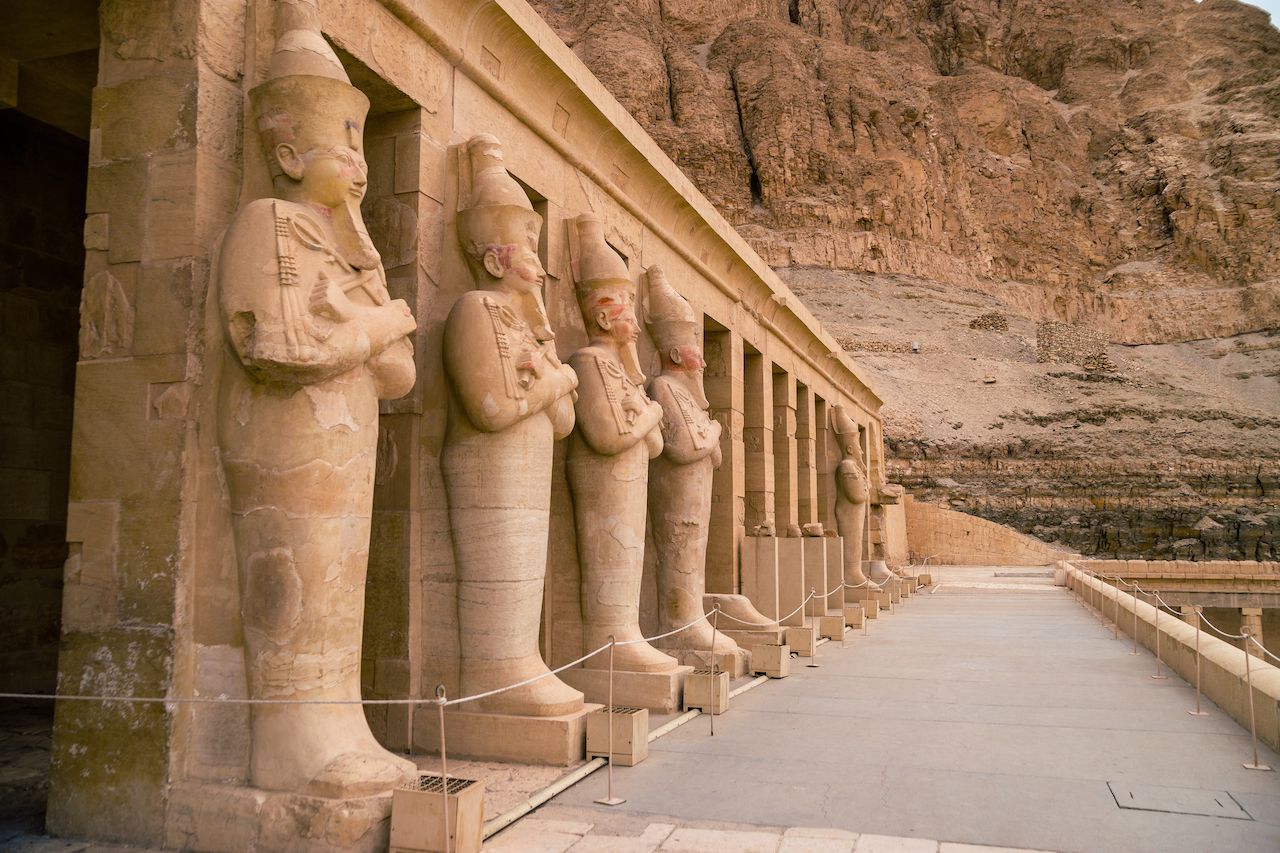
Photo: VIIIPhotography/Shutterstock
The grandiose temple was built during her rule, and it’s thought that she specifically chose that location — near the Valley of the Kings and the funerary temple of Mentuhotep II — to emphasize her power. There are three colonnaded levels, with reliefs displaying scenes from Hatshepshut’s time as a monarch all throughout. Within the temple are shrines to gods Amun, Hathor, Anubis, and Ra, some of which have hieroglyphics and reliefs retaining some of their original colors. The statues of Hatshepsut on the highest level show her dressed as a male pharaoh would have been. After her death, many monuments dedicated to her were destroyed and dumped at the temple by Thutmose III, her stepson, in an effort to erase all traces of her rule.
Price: 120 Egyptian pounds ($7)
Where: Kings Valley Rd, Qesm Al Wahat Al Khargah, New Valley Governorate, Egypt
3. Philae Temple
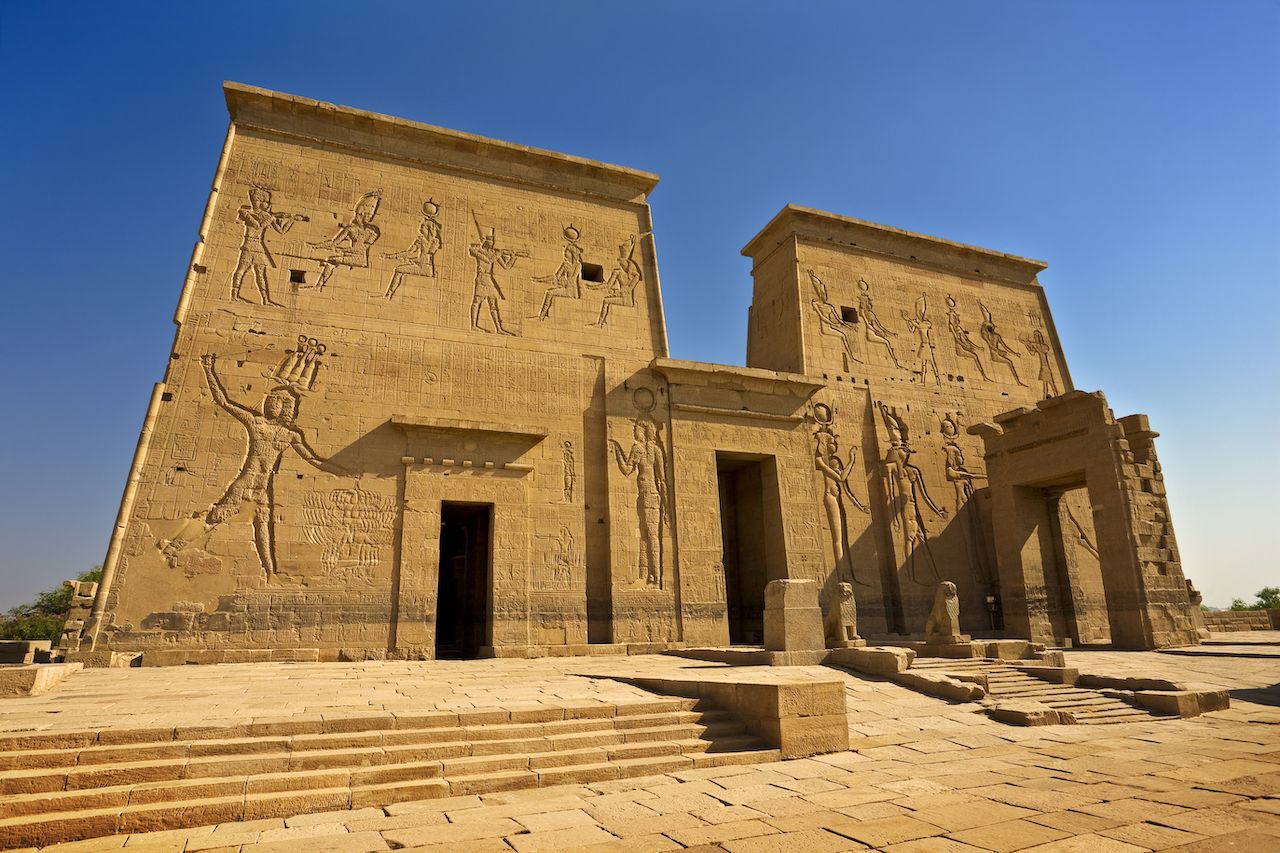
Photo: WitR/Shutterstock
Since this temple complex is located on a small island in the Nile River, getting here will require a short boat trip. The name comes from the complex’s original location on the island of Philae, just a few minutes away from its current location on Agilkia Island; it was moved due to high water levels that later submerged Philae. It was built in the seventh century BC and dedicated to the goddess Isis, though another smaller temple was built within the complex to honor Hathor.
Upon arrival, visitors are greeted by a pylon (a gateway-like structure) over 25 feet tall with large reliefs of Egyptian gods carved into it and three entry points: The entryway in the middle leads to the main courtyard while the ones on either side of it lead to small chambers. The main courtyard has columns on either side and another pylon, through which visitors access the inner temple and sanctuary. On the western side of the courtyard is the mammisi (birth house), built in honor of the god Horus’ birth and dedicated to both Isis, his mother, and Hathor, also known as the goddess of fertility. Inside the birth house are images of Horus’ life, from birth to throughout his childhood.
Price: 140 Egyptian pounds ($8)
Where: Aswan, Aswan Governorate, Egypt
4. Luxor Temple
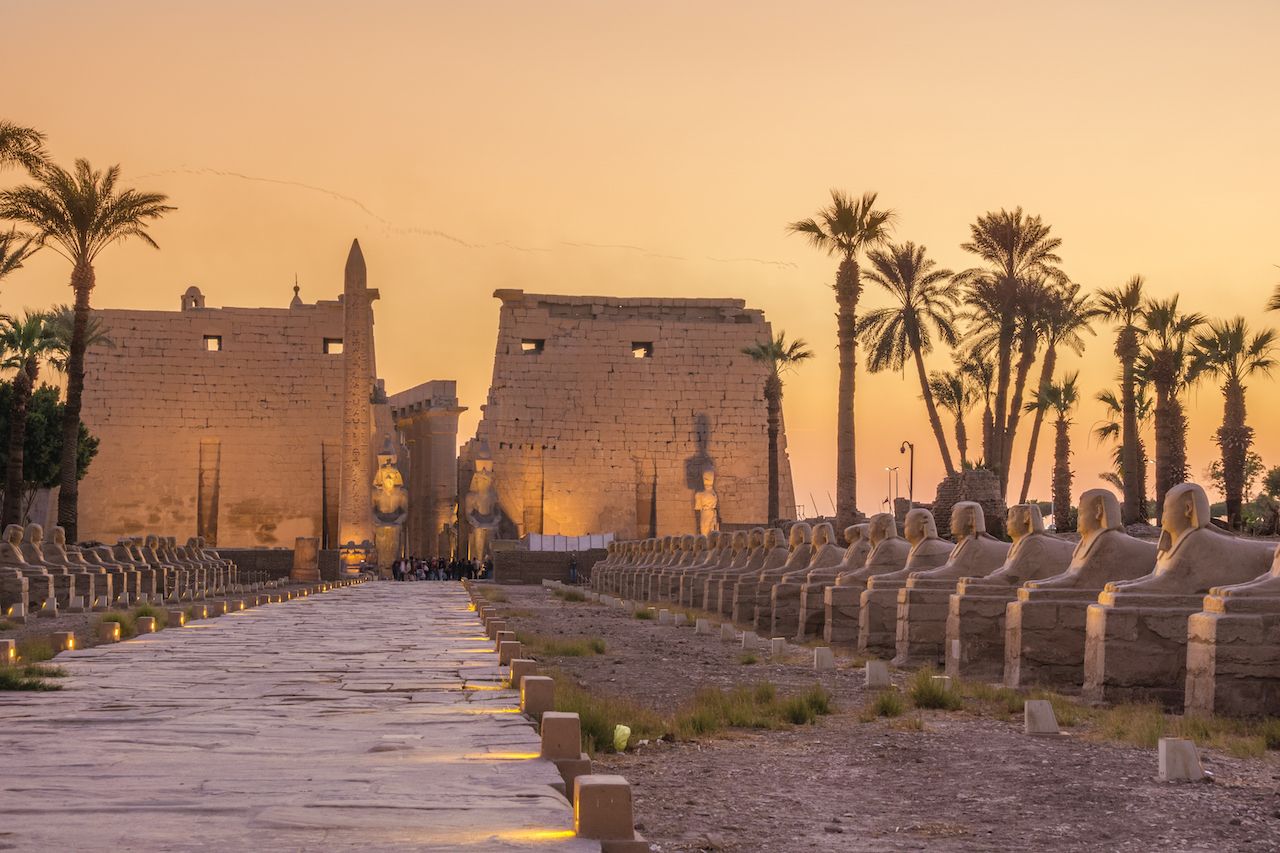
Photo: Prin Adulyatham/Shutterstock
Built in the 13th century BC through the efforts of multiple pharaohs, Luxor Temple can be found in Luxor, one of the more modern cities in Egypt. Its Egyptian name, ipet resyt, translates as “southern sanctuary,” which is apt considering its location in the southern part of the country.
An avenue of sphinx statues leads up to the temple’s entrance, which displays two statues of Ramses II sitting and three standing. In front of the Ramses statues used to be two obelisks, though only one remains with the other now located in Paris, France. Past this is the Great Court of Ramses II, a courtyard surrounded by two rows of columns depicting the pharaoh worshipping the gods; also in the courtyard are statues of all of Ramses’ sons, as well as a shrine built by Hatshepshut that was later taken over by Thutmose III.
Beyond is a long pathway lined by open-flower columns over 50 feet tall, known as the Colonnade of Amenhotep III, which leads to the Court of Amenhotep III. The hypostyle hall is the final space visitors pass through before entering the temple’s inner rooms and is best seen at night when the four rows of eight columns on all sides are lit up, giving off a spectacularly mysterious vibe. While the temple seems to exist on an open-air plan, it used to be enclosed in its heyday; much of the walls were removed to be reused as building materials for other structures.
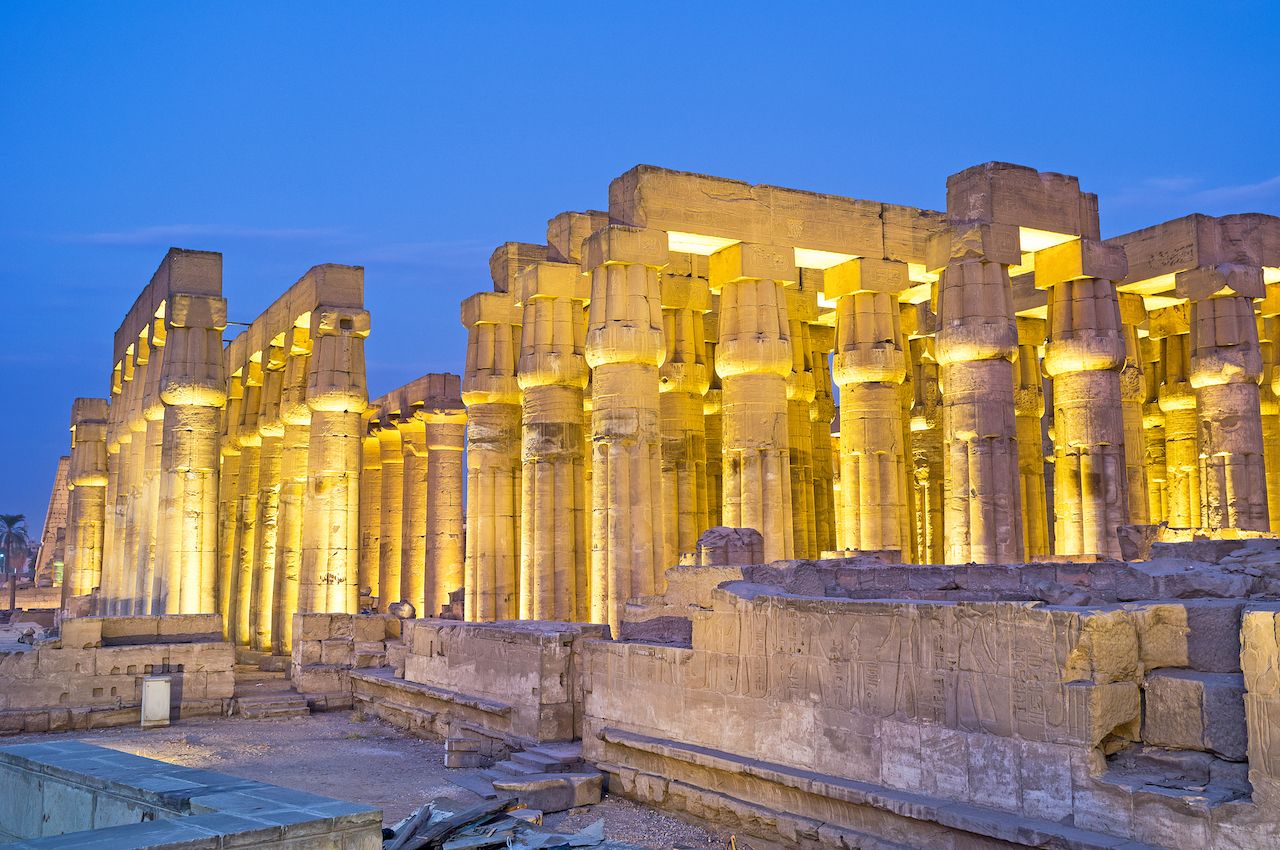
Photo: eFesenko/Shutterstock
The main rooms of the temple are the only ones that remain enclosed by walls and a roof; they’re considered “inside,” and these contain shrines to Amun, Amenhotep III’s birth room (with images of his birth), and the inner sanctuary. One room in particular was painted over by Romans with scenes of Roman life, and another shrine was rebuilt by Alexander the Great with images that show him as a pharaoh.
Price: 140 Egyptian pounds ($8)
Where: Luxor City, Luxor, Luxor Governorate, Egypt
5. Karnak Temple
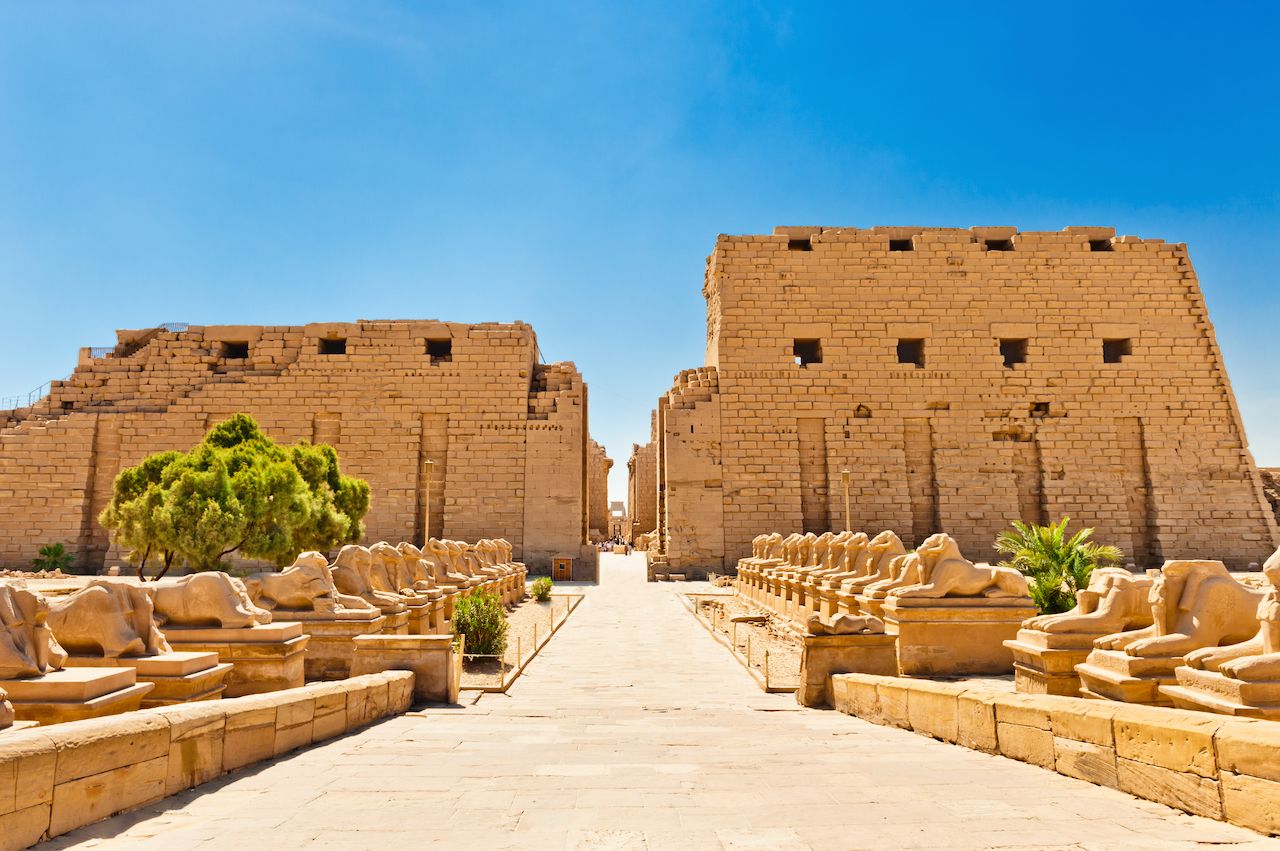
Photo: moonfish8/Shutterstock
Karnak Temple is considered to be the largest temple complex in Egypt and one of the largest in the world. It’s dedicated to a group of gods known as the Thebian Triad — Amun, Mut, and Khonsu — who were popular in the ancient city of Thebes, now ruins in part of Luxor. Its earliest structures date back over four millennia though it has been frequently added to over the years by different rulers.

Photo: serpetko/Shutterstock
An avenue of rams leads the way to the first pylon, though many of their faces have deteriorated over the years. Beyond that, visitors can easily spend hours exploring all of the parts of the complex that are open to the public. The main draw is the vast hypostyle hall, around 54,000 square feet, with over 100 columns that are about 40 feet high; twelve of those columns tower above the rest at a height nearly double that of their neighbors, so as to allow natural light and air inside the space. This part of the complex’s construction is attributed to Seti I and Ramses II, and reliefs carved here depict different victories of the two rulers. Also interesting is the sacred lake within the complex, said to be dedicated to Mut and filled with water from the Nile.
Price: 150 Egyptian pounds ($9)
Where: El-Karnak, Luxor, Luxor Governorate, Egypt
6. Temple of Horus
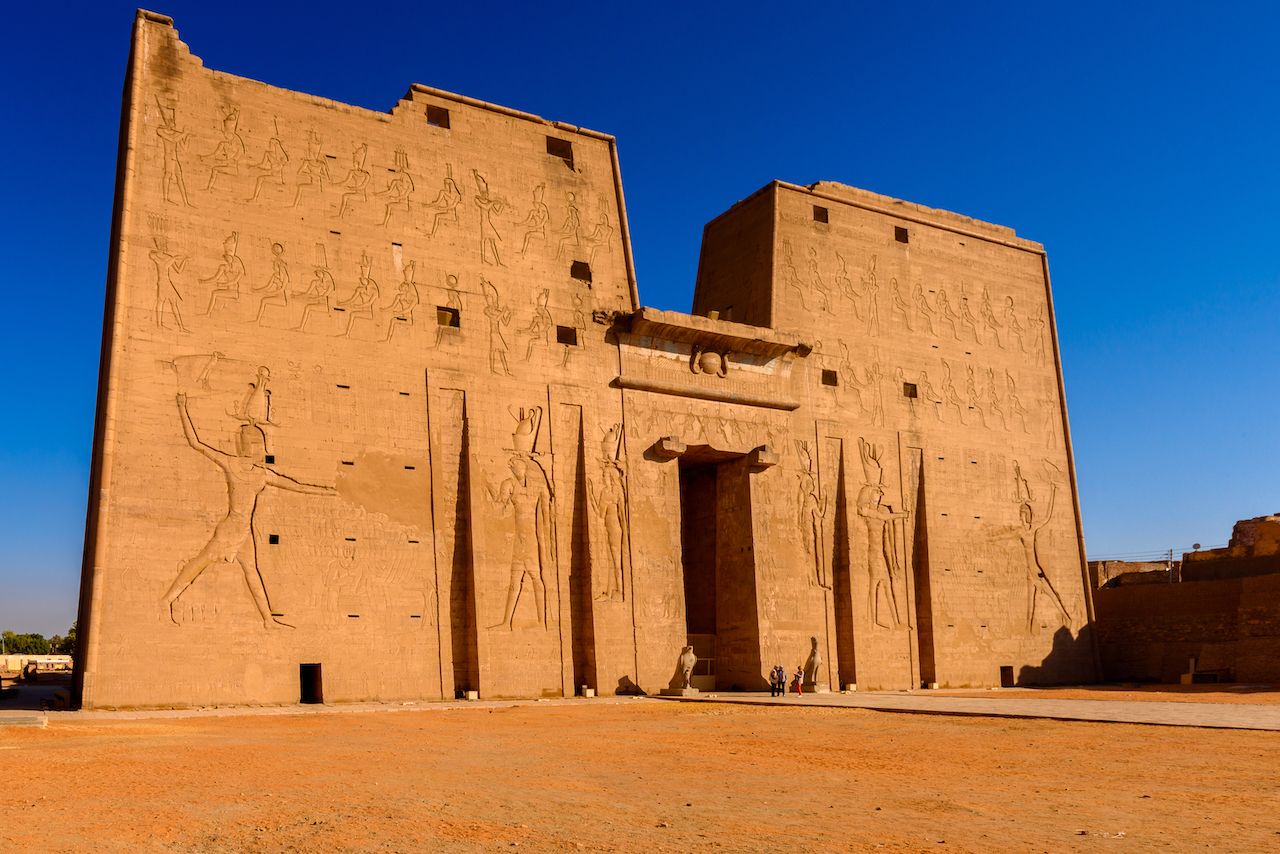
Photo: Anton_Ivanov/Shutterstock
Also known Edfu Temple, this temple is dedicated to Horus, a god often depicted with the head of the falcon. The entryway at the first pylon is guarded by two granite statues of Horus as a complete falcon, and through it is an indoor court with a number of columns. Looking up you’ll find two things: the first being that many parts of the roof and tops of the columns are darkened, and Egyptologists believe that this is due to groups of soldiers that took residence within the temple and started fires for various reasons (such as cooking and to keep warm); the second is that some of the hieroglyphics toward the top of the columns and on the roof still retain some original coloring, albeit faded.
Past this room is the outer hypostyle hall with another pylon, though this one only has one granite falcon statue remaining. Further inside the temple is the sanctuary, with a granite shrine that at one point used to house a statue of Horus (it’s now in the Louvre in Paris). In front of the shrine is a replica of a boat that was used to transport the statue of Horus in and out of the temple for celebratory occasions.
Price: 140 Egyptian pounds ($8)
Where: Adfo, Markaz Edfo, Aswan Governorate, Egypt
7. Temple of Kom Ombo
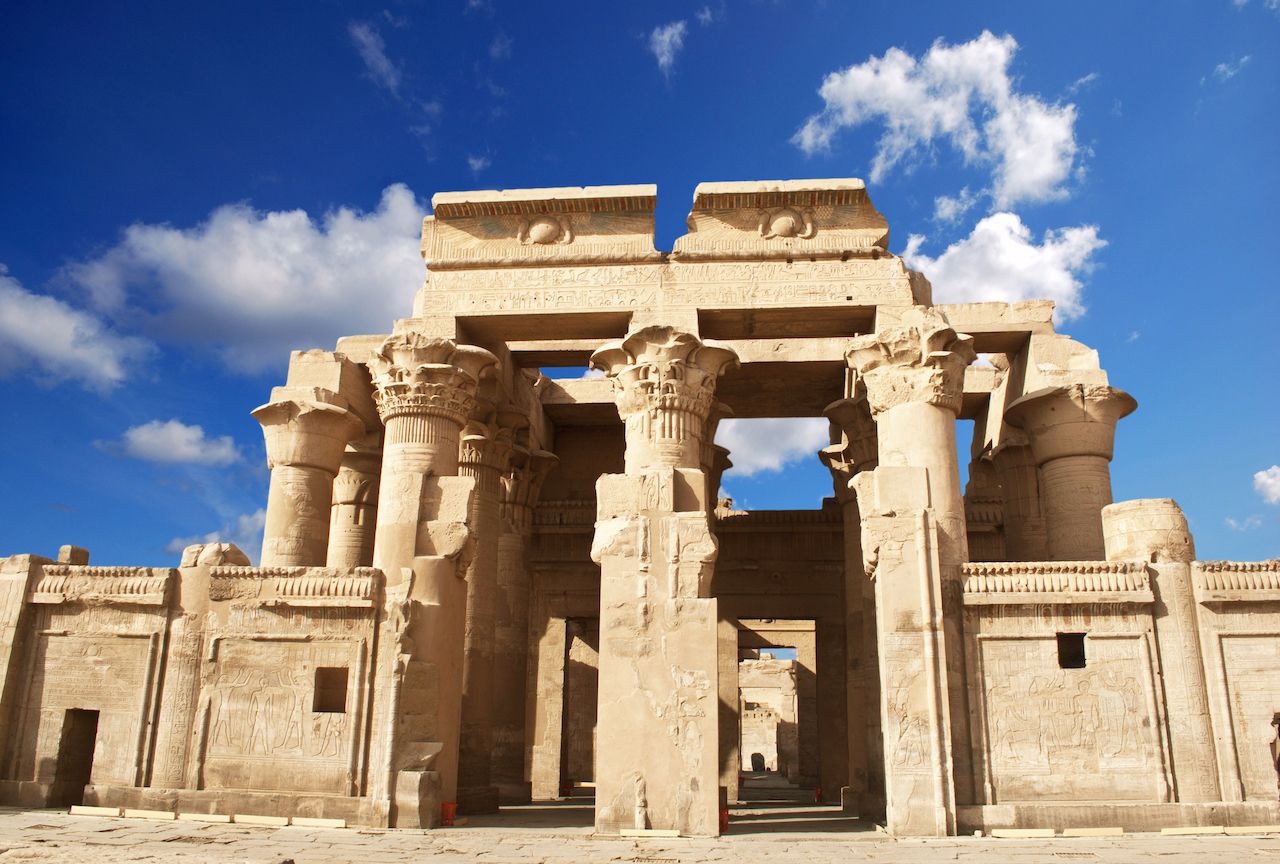
Photo: Waj/Shutterstock
While it’s not uncommon for Egyptian temples to be dedicated to multiple gods, Kom Ombo is unique in that it is a double temple. There are two sets of everything — entryways, hallways, etc. Each side is dedicated to a different god; the left side is for Horus, and the right side is for the crocodile god Sobek.
While the temple’s entirety warrants full attention, there are two parts that visitors should particularly focus on. The first is the nilometer on the eastern perimeter of the temple. A nilometer was a structure used to measure the Nile’s water levels during its yearly flood season and determine the forecast of the upcoming harvest season. Typically, there would be a mark somewhere in the middle of a nilometer to show that if the water reached that point, there would be a good harvest to come; too low a level meant famine, too high meant terrible flooding. The one found at Kom Ombo is shaped like a well, with a staircase and entry point midway down, and while that’s unaccessible to visitors, you can peer down into the well from the surface level.
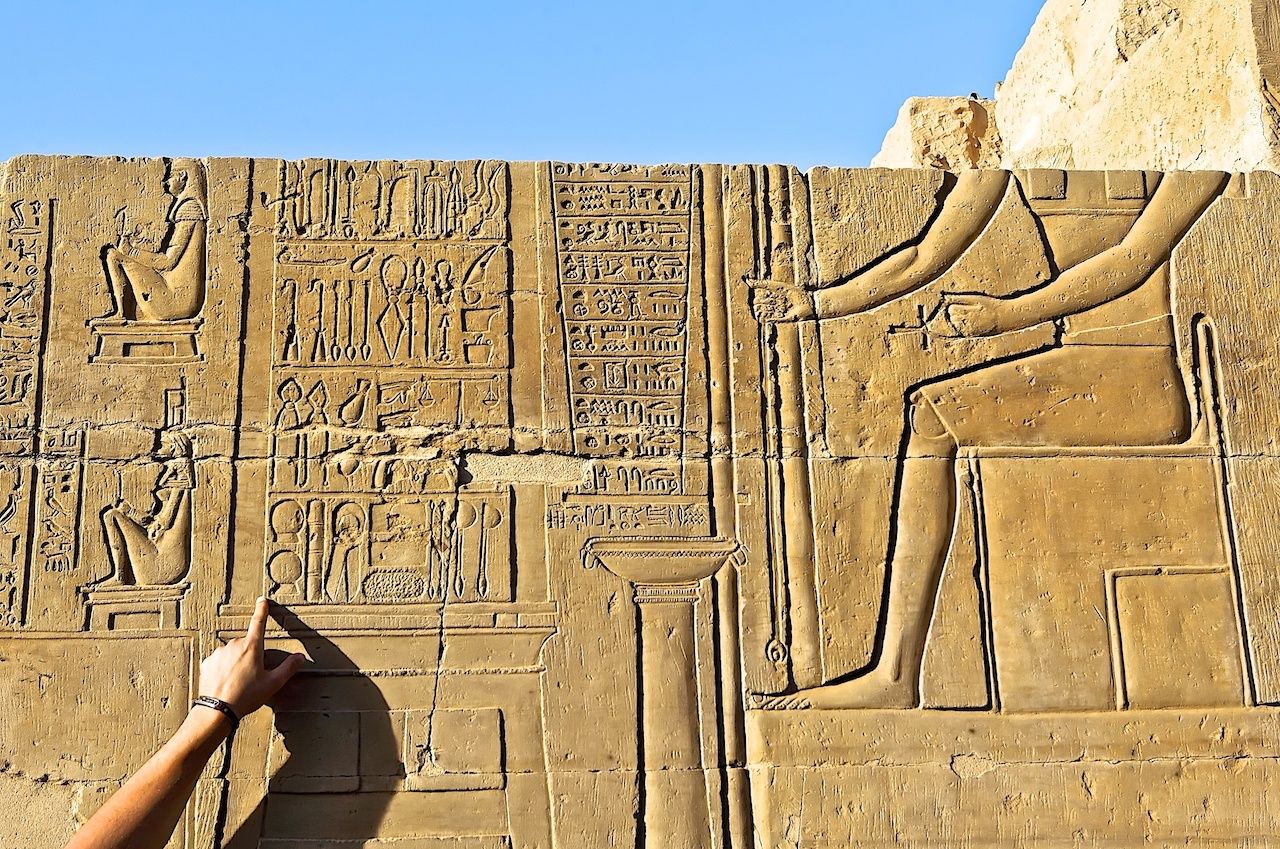
Photo: unterwegs/Shutterstock
The second is a set of hieroglyphics and reliefs found on a wall on the outer edge of the temple. Part of these are of some kind of tools, believed by many to be the first depictions of medical instruments. Beside these are reliefs of a woman sitting down; these show the ancient Egyptian method of predicting a baby’s gender. In ancient times, if a woman wanted to know her baby’s gender, she would urinate on a bag of barley and a bag of wheat, and whichever grew first would indicate the gender — male if it was the barley and female if it was the wheat.
Price: 100 Egyptian pounds ($6)
Where: Adfo, Markaz Edfo, Aswan Governorate, Egypt